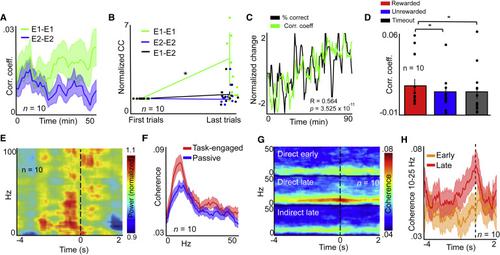Our official English website, www.x-mol.net, welcomes your
feedback! (Note: you will need to create a separate account there.)
Volitional Modulation of Primary Visual Cortex Activity Requires the Basal Ganglia
Neuron ( IF 14.7 ) Pub Date : 2018-03-01 , DOI: 10.1016/j.neuron.2018.01.051 Ryan M Neely 1 , Aaron C Koralek 2 , Vivek R Athalye 3 , Rui M Costa 4 , Jose M Carmena 5
Neuron ( IF 14.7 ) Pub Date : 2018-03-01 , DOI: 10.1016/j.neuron.2018.01.051 Ryan M Neely 1 , Aaron C Koralek 2 , Vivek R Athalye 3 , Rui M Costa 4 , Jose M Carmena 5
Affiliation

|
Animals acquire behaviors through instrumental conditioning. Brain-machine interfaces have used instrumental conditioning to reinforce patterns of neural activity directly, especially in frontal and motor cortices, which are a rich source of signals for voluntary action. However, evidence suggests that activity in primary sensory cortices may also reflect internally driven processes, instead of purely encoding antecedent stimuli. Here, we show that rats and mice can learn to produce arbitrary patterns of neural activity in their primary visual cortex to control an auditory cursor and obtain reward. Furthermore, learning was prevented when neurons in the dorsomedial striatum (DMS), which receives input from visual cortex, were optogenetically inhibited, but not during inhibition of nearby neurons in the dorsolateral striatum. After learning, DMS inhibition did not affect production of the rewarded patterns. These data demonstrate that cortico-basal ganglia circuits play a general role in learning to produce cortical activity that leads to desirable outcomes.
中文翻译:

初级视觉皮层活动的意志调节需要基底神经节
动物通过工具调节获得行为。脑机接口利用仪器调节直接强化神经活动模式,特别是额叶皮层和运动皮层,它们是自愿行动的丰富信号源。然而,有证据表明,初级感觉皮层的活动也可能反映内部驱动的过程,而不是纯粹编码先前的刺激。在这里,我们证明大鼠和小鼠可以学习在其初级视觉皮层中产生任意的神经活动模式,以控制听觉光标并获得奖励。此外,当从视觉皮层接收输入的背内侧纹状体(DMS)中的神经元受到光遗传学抑制时,学习会被阻止,但在背外侧纹状体中附近的神经元受到抑制时,学习不会被阻止。学习后,DMS 抑制不会影响奖励模式的产生。这些数据表明,皮质基底神经节回路在学习产生可导致理想结果的皮质活动中发挥着普遍作用。
更新日期:2018-03-01
中文翻译:

初级视觉皮层活动的意志调节需要基底神经节
动物通过工具调节获得行为。脑机接口利用仪器调节直接强化神经活动模式,特别是额叶皮层和运动皮层,它们是自愿行动的丰富信号源。然而,有证据表明,初级感觉皮层的活动也可能反映内部驱动的过程,而不是纯粹编码先前的刺激。在这里,我们证明大鼠和小鼠可以学习在其初级视觉皮层中产生任意的神经活动模式,以控制听觉光标并获得奖励。此外,当从视觉皮层接收输入的背内侧纹状体(DMS)中的神经元受到光遗传学抑制时,学习会被阻止,但在背外侧纹状体中附近的神经元受到抑制时,学习不会被阻止。学习后,DMS 抑制不会影响奖励模式的产生。这些数据表明,皮质基底神经节回路在学习产生可导致理想结果的皮质活动中发挥着普遍作用。











































 京公网安备 11010802027423号
京公网安备 11010802027423号